
|
Brightening very rapidly. Now it is so bright as 4.6 mag (Dec. 29, Chris Wyatt). It is visible with naked eyes. It will approach to the earth in December and January, and it is expected to brighten up to 4 mag. In the Southern Hemisphere, it keeps observable in excellent condition until late January. In the Northern Hemisphere, it keeps extremely low until mid December. But after that, it will be observable in excellent condition.
Date(TT) R.A. (2000) Decl. Delta r Elong. m1 Best Time(A, h)
Dec. 27 5 39.18 -28 23.5 0.551 1.388 127 5.1 23:11 ( 0, 28)
Jan. 3 4 49.94 -14 44.8 0.482 1.353 131 4.5 21:55 ( 0, 42)
|
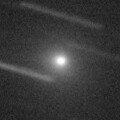
|
It brightened very rapidly in outburst up to 8.8 mag on Dec. 19 (Marco Goiato). It is bright as 10.4 mag still now (Dec. 28, Carlos Labordena). It keeps 9-10 mag until January. In the Northern Hemisphere, it will be geting higher gradually. In the Southern Hemisphere, it will be getting lower gradually, and it keeps extremely low after January.
Date(TT) R.A. (2000) Decl. Delta r Elong. m1 Best Time(A, h)
Dec. 27 21 22.71 -16 25.1 1.428 0.976 42 10.5 18:26 ( 52, 20)
Jan. 3 21 54.46 -13 0.1 1.407 0.981 44 10.2 18:30 ( 55, 22)
|

|
It brightened up to 6.9 mag in autumn (Oct. 17, Marco Goiato). Now it is fading. But it is bright as 11.0 mag still now (Dec. 29, Chris Wyatt). It is observable in excellent condition in the Southern Hemisphere. In the Northern Hemisphere, it is observable in the evening low sky in December and January.
Date(TT) R.A. (2000) Decl. Delta r Elong. m1 Best Time(A, h)
Dec. 27 0 11.98 -35 24.5 2.175 2.140 74 10.3 18:26 ( 8, 19)
Jan. 3 0 8.64 -33 0.0 2.378 2.223 68 10.6 18:30 ( 16, 20)
|
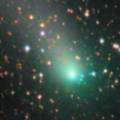
|
The brightness evolution has slowed down before the perihelion passage, and it faded down to 11.6 mag in late October (Oct. 26, Todd Augustyniak). However, an outburst occured around Nov. 10-12, and it brightened by 2 mag. It is bright as 10.4 mag still now (Nov. 29, Seiichi Yoshida). In the Northern Hemisphere, it became unobservable temporarily in December. But it will be observable in excellent condition after January while the comet will be fading. In the Southern Hemisphere, it will keep locating extremely low after this.
Date(TT) R.A. (2000) Decl. Delta r Elong. m1 Best Time(A, h)
Dec. 27 17 56.49 -0 32.3 2.516 1.662 23 10.7 5:35 (270, 0)
Jan. 3 17 58.99 1 38.2 2.524 1.716 27 10.9 5:38 (273, 6)
|

|
It will brighten up to 8-9 mag in 2015 spring. In the Southern Hemisphere, it will become observable in January, then it keeps observable in good condition after that. In the Northern Hemisphere, it keeps extremely low and hard to observe from December to 2015 June. It will be observable in good condition after June while the comet will be fading gradually.
Date(TT) R.A. (2000) Decl. Delta r Elong. m1 Best Time(A, h)
Dec. 27 16 8.00 -20 24.9 2.492 1.726 31 12.4 5:35 (302, 9)
Jan. 3 16 28.95 -21 26.6 2.419 1.684 33 12.0 5:38 (305, 9)
|

|
Now it is so bright as 10.9 mag (Dec. 20, Marek Biely). It keeps observable in the morning low sky at the same brightness for a while. In the Southern Hemisphere, it is too low to observe until December.
Date(TT) R.A. (2000) Decl. Delta r Elong. m1 Best Time(A, h)
Dec. 27 14 54.96 -8 32.1 1.847 1.455 51 12.1 5:35 (307, 29)
Jan. 3 15 15.21 -9 47.6 1.857 1.496 53 12.3 5:38 (310, 30)
|
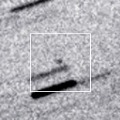
|
It will brighten very rapidly, and will brighten up to 11 mag from January to February. In the Southern Hemisphere, it will be observable in the morning sky after late February while the comet will be fading. It is hardly observable in the Northern Hemisphere.
Date(TT) R.A. (2000) Decl. Delta r Elong. m1 Best Time(A, h)
Dec. 27 16 53.76 -14 22.8 2.162 1.309 22 13.0 5:35 (291, 4)
Jan. 3 17 19.58 -16 6.8 2.132 1.285 22 12.6 5:38 (293, 4)
|
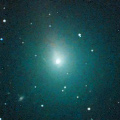
|
It brightened rapidly, and reached up to 10.3 mag in autumn (Oct. 22, Bob King). Now it is fading, but it is bright as 12.1 mag still now (Nov. 29, Seiichi Yoshida). In the Northern Hemisphere, it keeps observable in good condition until the comet will fade out in next spring. It is not observable in the Southern Hemisphere.
Date(TT) R.A. (2000) Decl. Delta r Elong. m1 Best Time(A, h)
Dec. 27 19 7.47 48 38.1 1.732 1.719 72 12.6 18:26 (131, 28)
Jan. 3 19 14.55 46 25.7 1.829 1.747 69 13.1 18:30 (131, 24)
|

|
The brightness evolution has slowed down just before the perihelion passage. But it brightened up to 6.5 mag in September (Sept. 21, Marco Goiato). Now it is fading. It has faded down to 10.6 mag in October (Oct. 21, Chris Wyatt). It is appearing in the morning sky in the Northern Hemisphere. It will be observable in mid January also in the Southern Hemisphere. It keeps observable in good condition after this, while the comet will be fading gradually.
Date(TT) R.A. (2000) Decl. Delta r Elong. m1 Best Time(A, h)
Dec. 27 16 1.76 -4 26.5 2.446 1.786 38 13.0 5:35 (291, 20)
Jan. 3 16 2.42 -3 7.3 2.440 1.888 45 13.2 5:38 (295, 27)
|
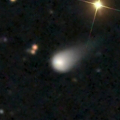
|
Now it is 13.6 mag (Dec. 19, Chris Wyatt). Getting brighter than originally expected, and it is already visible visually. It is expected to brighten up to 4 mag from autumn to winter in 2015. It is observable in good condition in the Southern Hemisphere until the highlight, or in the Northern Hemisphere after the highlight.
Date(TT) R.A. (2000) Decl. Delta r Elong. m1 Best Time(A, h)
Dec. 27 22 23.55 -24 56.5 5.005 4.509 54 13.5 18:26 ( 35, 21)
Jan. 3 22 25.00 -24 41.0 5.029 4.437 48 13.5 18:30 ( 41, 17)
|

|
Now it is 13.8 mag (Dec. 29, Chris Wyatt). It is fainter than originally predicted by 2 mag. In the Northern Hemisphere, it keeps observable at 14 mag in excellent condition from 2014 summer to 2015 spring. It locates somewhat low in the Southern Hemisphere.
Date(TT) R.A. (2000) Decl. Delta r Elong. m1 Best Time(A, h)
Dec. 27 11 35.93 16 52.9 1.592 2.099 106 13.9 5:15 ( 0, 72)
Jan. 3 11 42.55 16 52.1 1.542 2.119 112 13.9 4:54 ( 0, 72)
|

|
Now it is not observable. It will appear in the morning sky again in January.
Date(TT) R.A. (2000) Decl. Delta r Elong. m1 Best Time(A, h)
Dec. 27 16 58.69 -29 42.3 7.001 6.083 19 14.1 5:35 (302, -6)
Jan. 3 17 4.80 -29 50.8 6.958 6.081 25 14.1 5:38 (305, -2)
|
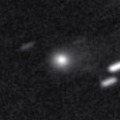
|
Now it is 14.8 mag (Sept. 16, Taras Prystavski). It is expected to brighten up to 13 mag and to be observable in good condition in 2015. It becomes unobservable temporarily from October to January.
Date(TT) R.A. (2000) Decl. Delta r Elong. m1 Best Time(A, h)
Dec. 27 16 51.42 -13 25.4 4.460 3.580 23 14.3 5:35 (290, 5)
Jan. 3 17 2.12 -13 36.6 4.404 3.564 27 14.2 5:38 (293, 9)
|
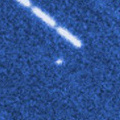
|
Now it is 17.5 mag (Dec. 15, iTelescope Observatory, Siding Spring). It will brighten up to 9 mag in 2015 spring. But the condition of this apparition is bad. In the Southern Hemisphere, it keeps observable until winter when the comet will be 13 mag. But it is not observable around the brightest days. In the Northern Hemispehre, it keeps extremely low and hard to observe. It will be observable after 2015 autumn when the comet will fade out.
Date(TT) R.A. (2000) Decl. Delta r Elong. m1 Best Time(A, h)
Dec. 27 22 2.95 -37 40.5 2.639 2.129 49 14.8 18:26 ( 32, 8)
Jan. 3 22 17.19 -35 53.0 2.638 2.078 45 14.5 18:30 ( 36, 7)
|
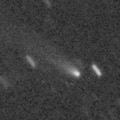
|
Now it is 14.8 mag (Dec. 12, Mike Wolle). It will be observable at 14 mag in excellent condition in winter.
Date(TT) R.A. (2000) Decl. Delta r Elong. m1 Best Time(A, h)
Dec. 27 23 54.27 1 8.5 1.039 1.357 84 14.6 18:26 ( 23, 54)
Jan. 3 0 12.36 3 58.3 1.059 1.346 82 14.6 18:30 ( 31, 56)
|

|
It brightened rapidly in outburst in mid October in 2013. Now it is fading. It has already faded down to 13.0 mag (Oct. 18, Con Stoitsis). In the Southern Hemisphere, it keeps observable in good condition for a long time until the comet fades out. In the Northern Hemisphere, it keeps extremely low after this.
Date(TT) R.A. (2000) Decl. Delta r Elong. m1 Best Time(A, h)
Dec. 27 22 40.15 -41 36.6 4.469 4.006 56 14.8 18:26 ( 24, 8)
Jan. 3 22 48.17 -40 45.3 4.600 4.071 52 14.9 18:30 ( 28, 7)
|
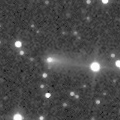
|
Now it is 14.7 mag (Nov. 28, Mt. Lemmon Survey). It keeps 15 mag until February, and it will be observable in excellent condition in the Northern Hemisphere. It locates somewhat low in the Southern Hemisphere.
Date(TT) R.A. (2000) Decl. Delta r Elong. m1 Best Time(A, h)
Dec. 27 6 47.08 26 12.6 1.496 2.476 173 14.9 0:28 ( 0, 81)
Jan. 3 6 40.67 25 38.8 1.495 2.477 176 14.9 23:49 ( 0, 81)
|

|
Now it is 14.9 mag (Nov. 22, Ken-ichi Kadota). It keeps 15 mag for a long time from 2014 to 2015. It is observable in excellent condition in 2014 in the Southern Hemisphere, or in 2015 in the Northern Hemisphere.
Date(TT) R.A. (2000) Decl. Delta r Elong. m1 Best Time(A, h)
Dec. 27 0 10.65 -17 58.3 3.978 3.939 80 15.0 18:26 ( 11, 36)
Jan. 3 0 11.93 -16 11.1 4.072 3.929 74 15.0 18:30 ( 21, 36)
|
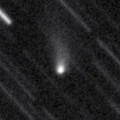
|
Now it is 16.1 mag (Nov. 13, J. Oey, P. Camilleri, H. Williams). The brightness evolution is somewhat slow. It keeps 15-16 mag for a long time from 2014 autumn to 2015 autumn. In the Southern Hemisphere, it keeps observable in excellent condition for a long time. In the Northern Hemisphere, it is unobservable until 2015 June.
Date(TT) R.A. (2000) Decl. Delta r Elong. m1 Best Time(A, h)
Dec. 27 5 1.64 -76 9.8 2.085 2.141 79 15.1 22:28 ( 0,-21)
Jan. 3 3 26.89 -74 38.2 2.102 2.113 77 15.0 20:30 ( 0,-19)
|

|
It brightened up to 11-12 mag in 2012. It has already faded down to 14.9 mag (Aug. 12, Taras Prystavski). Appearing in the morning sky again. It will be observable at 15 mag in good condition again in 2015.
Date(TT) R.A. (2000) Decl. Delta r Elong. m1 Best Time(A, h)
Dec. 27 12 7.25 -10 32.6 8.688 8.727 89 15.1 5:35 (356, 44)
Jan. 3 12 5.63 -10 34.3 8.599 8.764 96 15.1 5:17 ( 0, 44)
|
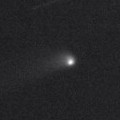
|
Now it is 15.4 mag (Oct. 28, Sandor Szabo). It will brighten up to 14 mag from 2015 to 2016. It is observable in good condition in the Southern Hemisphere. It locates somewhat low in the Northern Hemisphere.
Date(TT) R.A. (2000) Decl. Delta r Elong. m1 Best Time(A, h)
Dec. 27 3 29.65 -22 14.8 4.136 4.681 118 15.3 21:06 ( 0, 33)
Jan. 3 3 21.08 -21 5.3 4.193 4.656 112 15.3 20:30 ( 0, 34)
|
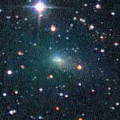
|
Now it is 13.7 mag (Nov. 29, Seiichi Yoshida). It will be observable at 14 mag in excellent condition from October to December.
Date(TT) R.A. (2000) Decl. Delta r Elong. m1 Best Time(A, h)
Dec. 27 5 4.23 38 16.5 0.886 1.834 157 15.3 22:41 (180, 87)
Jan. 3 5 1.19 38 50.0 0.935 1.859 151 15.6 22:10 (180, 86)
|

|
Now it is 13.5 mag (Oct. 25, Seiichi Yoshida). It keeps bright as 13-14 mag for a long time from 2013 to 2014.
Date(TT) R.A. (2000) Decl. Delta r Elong. m1 Best Time(A, h)
Dec. 27 21 49.37 -20 58.9 3.907 3.330 47 15.4 18:26 ( 44, 20)
Jan. 3 21 58.37 -20 3.6 3.991 3.342 43 15.4 18:30 ( 49, 17)
|

|
Now it is 13.3 mag (Sept. 22, Seiichi Yoshida). It will be unobservable temporarily in winter, but it will be observable at 15-16 mag in good condition again in 2015.
Date(TT) R.A. (2000) Decl. Delta r Elong. m1 Best Time(A, h)
Dec. 27 18 39.15 -14 48.2 8.141 7.173 9 15.4 18:26 ( 79,-10)
Jan. 3 18 41.82 -15 5.1 8.171 7.200 8 15.4 5:38 (280,-12)
|
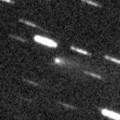
|
Now it is 14.0 mag and visible visually (Nov. 29, Seiichi Yoshida). It keeps observable for a long time after this while the comet will be fading gradually.
Date(TT) R.A. (2000) Decl. Delta r Elong. m1 Best Time(A, h)
Dec. 27 10 0.69 0 12.7 1.896 2.558 122 15.5 3:40 ( 0, 55)
Jan. 3 9 58.66 0 8.7 1.863 2.600 129 15.6 3:11 ( 0, 55)
|
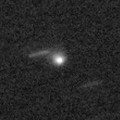
|
It will approach to the sun down to 0.3 a.u. in 2015 July, and it is expected to be bright. Now it is 16.0 mag (Nov. 15, Ken-ichi Kadota). It keeps observable while the comet will be brightening gradually until January when the comet will be 15 mag. The condition is bad after that and it will be hard to observe. But in the Southern Hemisphere, it will be observable after mid July in 2015, and keeps observable while the comet will be fading gradually. In the Northern Hemisphere, it is extremely hard to observe after 2015.
Date(TT) R.A. (2000) Decl. Delta r Elong. m1 Best Time(A, h)
Dec. 27 22 51.19 -23 18.1 3.729 3.368 61 15.6 18:26 ( 30, 26)
Jan. 3 22 54.07 -22 14.7 3.737 3.280 55 15.5 18:30 ( 37, 23)
|
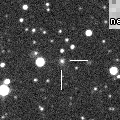
|
Now it is 15.7 mag (Nov. 13, A. Klotz, F. Kugel, J. Nicolas). In the Northern Hemisphere, it keeps 15-16 mag and observable in excellent condition for a long time until early summer in 2015. In the Southern Hemisphere, it is not observable until mid January.
Date(TT) R.A. (2000) Decl. Delta r Elong. m1 Best Time(A, h)
Dec. 27 13 16.54 32 41.5 3.405 3.573 91 15.7 5:35 (272, 73)
Jan. 3 13 22.24 32 41.7 3.342 3.585 96 15.7 5:38 (278, 78)
|

|
Now it is 14.2 mag (Oct. 4, Jakub Cerny). It keeps 13-14 mag and observable in good condition in the Northern Hemisphere for a long time from 2013 to 2014. It locates low in the Southern Hemisphere. Two fragments, B and C, are also visible at 18-20 mag.
Date(TT) R.A. (2000) Decl. Delta r Elong. m1 Best Time(A, h)
Dec. 27 22 40.51 18 43.5 4.906 4.763 75 15.7 18:26 ( 68, 57)
Jan. 3 22 43.19 17 43.0 5.060 4.804 69 15.8 18:30 ( 74, 51)
|
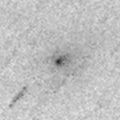
|
Now it is 15.5 mag (Oct. 28, Sandor Szabo). It keeps 15 mag from autumn to winter, but it is extremely diffuse.
Date(TT) R.A. (2000) Decl. Delta r Elong. m1 Best Time(A, h)
Dec. 27 9 37.64 -23 1.3 1.396 2.003 113 15.7 3:17 ( 0, 32)
Jan. 3 9 33.02 -26 47.0 1.397 2.041 116 15.8 2:45 ( 0, 28)
|
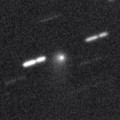
|
Now it is 15.5 mag (Nov. 29, Catalina Sky Survey). It keeps observable at 15-16 mag for a long time from 2015 to 2016. In the Northern Hemisphere, it is observable in excellent condition. It locates somewhat low in the Southern Hemisphere.
Date(TT) R.A. (2000) Decl. Delta r Elong. m1 Best Time(A, h)
Dec. 27 3 7.47 27 5.4 4.857 5.609 136 15.9 20:44 ( 0, 82)
Jan. 3 3 3.65 27 27.4 4.924 5.589 128 15.9 20:13 ( 0, 83)
|
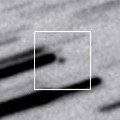
|
Now it is 15.3 mag (Nov. 27, Mt. Lemmon Survey). It will pass the perihelion on Mar. 15. In the Northern Hemispehre, it keeps observable in good condition until late February. In the Southern Hemisphere, it keeps observable until mid February, but it locates low.
Date(TT) R.A. (2000) Decl. Delta r Elong. m1 Best Time(A, h)
Dec. 27 2 1.28 25 18.8 0.773 1.534 121 16.1 19:37 ( 0, 80)
Jan. 3 1 44.07 21 38.8 0.793 1.455 109 16.2 18:53 ( 0, 77)
|
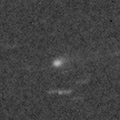
|
Now it is 16.6 mag (Nov. 19, Catalina Sky Survey). It will brighten up to 16 mag and will be observable in excellent condition in winter.
Date(TT) R.A. (2000) Decl. Delta r Elong. m1 Best Time(A, h)
Dec. 27 11 53.39 5 3.1 1.694 2.080 98 16.2 5:32 ( 0, 60)
Jan. 3 12 1.38 4 45.3 1.633 2.095 103 16.1 5:13 ( 0, 60)
|
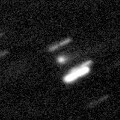
|
Now it is 16.2 mag (Nov. 24, Mt. Lemmon Survey). It will brighten up to 16 mag in winter, and will be observable in excellent condition.
Date(TT) R.A. (2000) Decl. Delta r Elong. m1 Best Time(A, h)
Dec. 27 8 22.75 12 49.9 3.209 4.086 149 16.3 2:03 ( 0, 68)
Jan. 3 8 19.75 12 48.8 3.166 4.089 156 16.3 1:32 ( 0, 68)
|
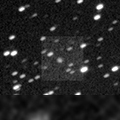
|
Now it is 16.8 mag (Nov. 15, J. F. Hernandez). It will pass close to the earth from spring to summer in 2016, and it is expected to be observable at 6-7 mag in good condition. In the Northern Hemispehre, it keeps observable in good condition until 2015 spring when the comet will brighten up to 15.5 mag. In the Southern Hemisphere, it keeps low for a long time until 2016 spring.
Date(TT) R.A. (2000) Decl. Delta r Elong. m1 Best Time(A, h)
Dec. 27 5 57.51 36 46.5 4.771 5.729 165 16.5 23:33 (180, 88)
Jan. 3 5 48.12 36 48.5 4.731 5.666 160 16.4 22:56 (180, 88)
|

|
Now it is 15.9 mag (Nov. 29, Ken-ichi Kadota). It will be higher gradually, and will be observable at 16-17 mag in good condition from winter to spring. It will be observable after January also in the Southern Hemisphere.
Date(TT) R.A. (2000) Decl. Delta r Elong. m1 Best Time(A, h)
Dec. 27 15 2.08 -8 21.7 2.340 1.866 49 16.4 5:35 (306, 28)
Jan. 3 15 18.97 -9 7.6 2.307 1.883 52 16.4 5:38 (309, 30)
|

|
It is bright as 14.1 mag still now (Oct. 25, Seiichi Yoshida). It will be fading after this. But it keeps observable until March when it becomes fainter than 18 mag.
Date(TT) R.A. (2000) Decl. Delta r Elong. m1 Best Time(A, h)
Dec. 27 0 15.38 -10 4.5 2.309 2.424 84 16.5 18:26 ( 11, 44)
Jan. 3 0 24.33 -8 55.3 2.408 2.439 80 16.7 18:30 ( 19, 44)
|

|
Now it is 17.2 mag (Nov. 19, V. Luna). It will brighten up to 13 mag in 2016. In the Northern Hemisphere, it will be observable at 16 mag in excellent condition in this winter. It locates somewhat low in the Southern Hemisphere.
Date(TT) R.A. (2000) Decl. Delta r Elong. m1 Best Time(A, h)
Dec. 27 6 12.65 28 21.2 2.248 3.229 174 16.7 23:48 ( 0, 83)
Jan. 3 6 5.96 28 23.9 2.235 3.203 168 16.6 23:14 ( 0, 83)
|
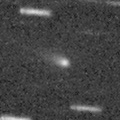
|
First return of a new periodic comet discovered in 2004. It brightened very rapidly as expected. Now it is 15.9 mag (Nov. 26, Catalina Sky Survey). It will be observable in excellent condition from autumn to winter.
Date(TT) R.A. (2000) Decl. Delta r Elong. m1 Best Time(A, h)
Dec. 27 0 46.76 7 24.8 0.958 1.473 98 16.7 18:26 ( 0, 63)
Jan. 3 1 9.43 8 7.4 1.019 1.500 97 16.9 18:30 ( 5, 63)
|

|
Now it is 16.8 mag (Dec. 13, K. Sarneczky). It keeps 17 mag until January, and it will be observable in excellent condition in the Northern Hemisphere.
Date(TT) R.A. (2000) Decl. Delta r Elong. m1 Best Time(A, h)
Dec. 27 4 55.41 47 32.3 0.898 1.819 150 17.0 22:32 (180, 77)
Jan. 3 4 49.37 49 37.8 0.926 1.816 144 17.0 21:58 (180, 75)
|

|
It brightened up to 13.8 mag from summer to autumn (Sept. 16, Taras Prystavski). Now it is fading rapidly. It has already faded down to 17.1 mag (Nov. 9, K. Hills). It keeps observable in good condition until February when the comet will be fainter than 18 mag.
Date(TT) R.A. (2000) Decl. Delta r Elong. m1 Best Time(A, h)
Dec. 27 0 27.23 -2 11.9 2.487 2.682 90 17.0 18:26 ( 9, 53)
Jan. 3 0 35.06 -1 16.4 2.610 2.715 85 17.3 18:30 ( 19, 52)
|

|
Now it is 16.9 mag (Nov. 18, R. Ligustri). It keeps 13 mag for a long time from 2015 to 2016, and will be observable in excellent condition in the Northern Hemisphere. In the Southern Hemisphere, it is observable only until mid 2015 March.
Date(TT) R.A. (2000) Decl. Delta r Elong. m1 Best Time(A, h)
Dec. 27 4 9.51 18 54.8 4.179 5.047 148 17.1 21:46 ( 0, 74)
Jan. 3 4 3.32 19 25.2 4.197 4.995 140 17.1 21:12 ( 0, 74)
|

|
First return of a peculiar asteroid 1998 HO121. It keeps observable at 17-18 mag from 2015 to 2016.
Date(TT) R.A. (2000) Decl. Delta r Elong. m1 Best Time(A, h)
Dec. 27 7 16.78 5 59.6 2.366 3.299 158 17.3 0:57 ( 0, 61)
Jan. 3 7 12.88 6 3.9 2.327 3.278 162 17.1 0:26 ( 0, 61)
|
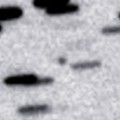
|
It keeps 17-18 mag for a long time from 2014 to 2016. Appearing in the morning sky again.
Date(TT) R.A. (2000) Decl. Delta r Elong. m1 Best Time(A, h)
Dec. 27 13 20.11 -21 13.0 5.614 5.339 68 17.2 5:35 (337, 30)
Jan. 3 13 18.07 -21 45.1 5.488 5.338 76 17.2 5:38 (346, 32)
|
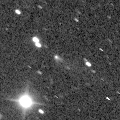
|
Now it is 18.9 mag (Nov. 20, Yasukazu Ikari). It was observed at 17 mag from 2013 to early 2014. It will be observable at 17.5 mag in good condition again from autumn to winter in 2014. But recently, it is fainter than this ephemeris.
Date(TT) R.A. (2000) Decl. Delta r Elong. m1 Best Time(A, h)
Dec. 27 8 35.82 12 42.7 2.467 3.331 146 17.3 2:16 ( 0, 68)
Jan. 3 8 32.04 12 44.9 2.433 3.346 154 17.3 1:45 ( 0, 68)
|
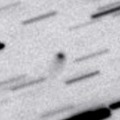
|
Now it is 16.8 mag (Sept. 11, E. Bryssinck). It keeps observable at 17-18 mag for a long time from 2013 to 2016. It keeps locating high in the Northern Hemisphere. It keeps locating very low in the Southern Hemipshere.
Date(TT) R.A. (2000) Decl. Delta r Elong. m1 Best Time(A, h)
Dec. 27 17 12.89 44 21.4 6.801 6.522 69 17.3 5:35 (235, 31)
Jan. 3 17 15.81 44 58.5 6.776 6.529 71 17.3 5:38 (236, 36)
|
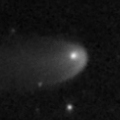
|
Now it is between 15.7 mag (Nov. 13, Yasukazu Ikari) and 19.1 mag (Nov. 25, A. Maury, J.-F. Soulier, J.-G. Bosch, T. Noel). Extremely diffuse, and hard to observe.
Date(TT) R.A. (2000) Decl. Delta r Elong. m1 Best Time(A, h)
Dec. 27 3 13.55 -3 17.7 8.699 9.325 127 17.3 20:50 ( 0, 52)
Jan. 3 3 11.48 -2 55.6 8.826 9.361 120 17.4 20:21 ( 0, 52)
|

|
Now it is 17.5 mag (Nov. 29, Ken-ichi Kadota). It was observed around 17-18 mag in early 2014. It will be observable around 17-18 mag again from 2014 autumn to 2015 spring, in excellent condition in the Northern Hemisphere. It is not observable in the Southern Hemisphere.
Date(TT) R.A. (2000) Decl. Delta r Elong. m1 Best Time(A, h)
Dec. 27 10 57.30 55 46.4 4.564 5.138 120 17.4 4:37 (180, 69)
Jan. 3 10 56.12 56 10.4 4.517 5.143 124 17.4 4:08 (180, 69)
|
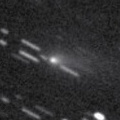
|
It brightened up to 2 mag by unusual major outburst in 2007. It brightened up to 12.6 mag in this apparition (June 25, Taras Prystavski). Now it is fading. It has already faded down to 16.3 mag (Dec. 2, Yasukazu Ikari). In the Northern Hemisphere, it keeps observable until it fades out in 2015. In the Southern Hemisphere, it keeps extremely low after this.
Date(TT) R.A. (2000) Decl. Delta r Elong. m1 Best Time(A, h)
Dec. 27 4 8.95 47 24.7 2.003 2.860 144 17.5 21:45 (180, 78)
Jan. 3 4 5.17 46 19.0 2.074 2.890 139 17.7 21:14 (180, 79)
|

|
Now it is 18.5 mag (Nov. 22, Mt. Lemmon Survey). It will brighten up to 11 mag in 2015 autumn. In this apparition, it is observable until the highlight while the comet is brightening.
Date(TT) R.A. (2000) Decl. Delta r Elong. m1 Best Time(A, h)
Dec. 27 12 45.78 -0 49.7 2.967 3.028 84 17.8 5:35 (340, 52)
Jan. 3 12 51.78 -1 15.0 2.828 2.989 89 17.5 5:38 (349, 53)
|
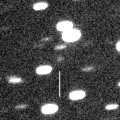
|
Now it is 19.6 mag (Dec. 2, A. Maury, J.-F. Soulier, J.-G. Bosch, T. Noel). Now it is around the aphelion. In the Northern Hemisphere, it is observable at 17.5 mag in good condition from winter to spring. It locates somewhat low in the Southern Hemisphere.
Date(TT) R.A. (2000) Decl. Delta r Elong. m1 Best Time(A, h)
Dec. 27 9 17.21 26 8.8 3.860 4.658 140 17.8 2:57 ( 0, 81)
Jan. 3 9 14.28 26 35.6 3.789 4.650 147 17.7 2:27 ( 0, 82)
|
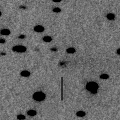
|
Now it is 17.1 mag (Nov. 22, Ken-ichi Kadota). It keeps observable at 17-18 mag from summer to winter in excellent condition in the Northern Hemisphere. It locates somewhat low in the Southern Hemisphere.
Date(TT) R.A. (2000) Decl. Delta r Elong. m1 Best Time(A, h)
Dec. 27 6 47.43 21 8.3 1.688 2.667 173 17.7 0:28 ( 0, 76)
Jan. 3 6 40.78 21 39.4 1.714 2.697 177 17.8 23:49 ( 0, 77)
|

|
Now it is 18.2 mag (Nov. 26, Catalina Sky Survey). It keeps observable at 17 mag from winter to spring. It is observable in excellent condition in the Southern Hemisphere. But it locates somewhat low in the Northern Hemisphere.
Date(TT) R.A. (2000) Decl. Delta r Elong. m1 Best Time(A, h)
Dec. 27 11 53.60 -7 57.1 2.986 3.195 93 17.9 5:33 ( 0, 47)
Jan. 3 11 54.20 -9 57.8 2.870 3.180 99 17.8 5:06 ( 0, 45)
|

|
Now it is 17.6 mag (Dec. 1, A. Maury, T. Noel, J.-F. Soulier, J.-G. Bosch). It keeps observable at 17-18 mag in good condition from winter to spring.
Date(TT) R.A. (2000) Decl. Delta r Elong. m1 Best Time(A, h)
Dec. 27 9 21.99 11 43.3 2.889 3.657 135 17.9 3:02 ( 0, 67)
Jan. 3 9 20.33 11 24.1 2.806 3.640 142 17.9 2:33 ( 0, 66)
|

|
It keeps 18 mag from 2014 to 2015. In 2015, it keeps observable in good condition from winter to spring.
Date(TT) R.A. (2000) Decl. Delta r Elong. m1 Best Time(A, h)
Dec. 27 11 0.72 -7 19.4 5.568 5.904 105 17.9 4:40 ( 0, 48)
Jan. 3 11 0.52 -7 57.0 5.473 5.912 111 17.9 4:12 ( 0, 47)
|

|
Peculiar asteroid with a cometary orbit of 45-years period. Now it is 18.3 mag (Oct. 4, M. Jaeger, et al.). It will brighten up to 17 mag from November to December, and will be observable in excellent condition.
Date(TT) R.A. (2000) Decl. Delta r Elong. m1 Best Time(A, h)
Dec. 27 3 10.40 2 41.0 2.102 2.831 129 17.9 20:46 ( 0, 58)
Jan. 3 2 58.54 0 44.8 2.239 2.850 119 18.1 20:07 ( 0, 56)
|

|
Now it is 18.1 mag (Mar. 29, M. Jaeger, W. Vollmann, E. Prosperi, S. Prosperi). It keeps 18 mag for a very long time from 2013 to 2018. It locates high in the Southern Hemisphere. But it locates somewhat low in the Northern Hemisphere.
Date(TT) R.A. (2000) Decl. Delta r Elong. m1 Best Time(A, h)
Dec. 27 12 20.82 -22 27.4 9.272 9.178 81 18.0 5:35 (353, 32)
Jan. 3 12 21.92 -22 46.1 9.159 9.175 87 17.9 5:34 ( 0, 32)
|
|
![]()
 305P/2014 N1 ( Skiff )
305P/2014 N1 ( Skiff ) P/2014 X1 ( Elenin )
P/2014 X1 ( Elenin ) P/2014 L2 ( NEOWISE )
P/2014 L2 ( NEOWISE ) C/2014 W2 ( PanSTARRS )
C/2014 W2 ( PanSTARRS ) (347449) 2012 TW236
(347449) 2012 TW236 C/2013 G9 ( Tenagra )
C/2013 G9 ( Tenagra ) 119P/Parker-Hartley
119P/Parker-Hartley C/2012 K8 ( Lemmon )
C/2012 K8 ( Lemmon ) C/2009 F4 ( McNaught )
C/2009 F4 ( McNaught ) C/2013 U2 ( Holvorcem )
C/2013 U2 ( Holvorcem ) 17P/Holmes
17P/Holmes 22P/Kopff
22P/Kopff 65P/Gunn
65P/Gunn 191P/McNaught
191P/McNaught C/2014 W6 ( Catalina )
C/2014 W6 ( Catalina ) C/2014 W11 ( PanSTARRS )
C/2014 W11 ( PanSTARRS ) C/2013 TW5 ( Spacewatch )
C/2013 TW5 ( Spacewatch ) 2013 NS11
2013 NS11 C/2013 C2 ( Tenagra )
C/2013 C2 ( Tenagra )![]()



















































